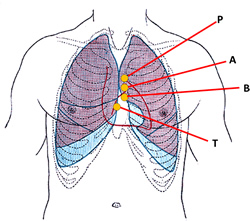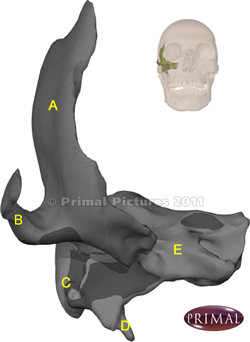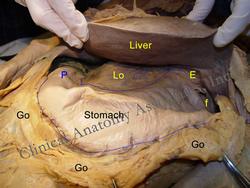
Medical Terminology Daily (MTD) is a blog sponsored by Clinical Anatomy Associates, Inc. as a service to the medical community. We post anatomical, medical or surgical terms, their meaning and usage, as well as biographical notes on anatomists, surgeons, and researchers through the ages. Be warned that some of the images used depict human anatomical specimens.
You are welcome to submit questions and suggestions using our "Contact Us" form. The information on this blog follows the terms on our "Privacy and Security Statement" and cannot be construed as medical guidance or instructions for treatment.
We have 894 guests online

Georg Eduard Von Rindfleisch
(1836 – 1908)
German pathologist and histologist of Bavarian nobility ancestry. Rindfleisch studied medicine in Würzburg, Berlin, and Heidelberg, earning his MD in 1859 with the thesis “De Vasorum Genesi” (on the generation of vessels) under the tutelage of Rudolf Virchow (1821 - 1902). He then continued as a assistant to Virchow in a newly founded institute in Berlin. He then moved to Breslau in 1861 as an assistant to Rudolf Heidenhain (1834–1897), becoming a professor of pathological anatomy. In 1865 he became full professor in Bonn and in 1874 in Würzburg, where a new pathological institute was built according to his design (completed in 1878), where he worked until his retirement in 1906.
He was the first to describe the inflammatory background of multiple sclerosis in 1863, when he noted that demyelinated lesions have in their center small vessels that are surrounded by a leukocyte inflammatory infiltrate.
After extensive investigations, he suspected an infectious origin of tuberculosis - even before Robert Koch's detection of the tuberculosis bacillus in 1892. Rindfleisch 's special achievement is the description of the morphologically conspicuous macrophages in typhoid inflammation. His distinction between myocardial infarction and myocarditis in 1890 is also of lasting importance.
Associated eponyms
"Rindfleisch's folds": Usually a single semilunar fold of the serous surface of the pericardium around the origin of the aorta. Also known as the plica semilunaris aortæ.
"Rindfleisch's cells": Historical (and obsolete) name for eosinophilic leukocytes.
Personal note: G. Rindfleisch’s book “Traité D' Histologie Pathologique” 2nd edition (1873) is now part of my library. This book was translated from German to French by Dr. Frédéric Gross (1844-1927) , Associate Professor of the Medicine Faculty in Nancy, France. The book is dedicated to Dr. Theodore Billroth (1829-1894), an important surgeon whose pioneering work on subtotal gastrectomies paved the way for today’s robotic bariatric surgery. Dr. Miranda.
Sources:
1. "Stedmans Medical Eponyms" Forbis, P.; Bartolucci, SL; 1998 Williams and Wilkins
2. "Rindfleisch, Georg Eduard von (bayerischer Adel?)" Deutsche Biographie
3. "The pathology of multiple sclerosis and its evolution" Lassmann H. (1999) Philos Trans R Soc Lond B Biol Sci. 354 (1390): 1635–40.
4. “Traité D' Histologie Pathologique” G.E.
Rindfleisch 2nd Ed (1873) Ballieres et Fils. Paris, Translated by F Gross
"Clinical Anatomy Associates, Inc., and the contributors of "Medical Terminology Daily" wish to thank all individuals who donate their bodies and tissues for the advancement of education and research”.
Click here for more information
- Details

Anterior view of the thorax, showing surface
relations of bones, lungs (purple), pleura (blue),
and heart (red outline).
P. Pulmonary valve. A. Aortic valve.
B. Bicuspid valve. T. Tricuspid valve
This is a combined word arising from terms [atrium], [ventricle], and [sulcus]. For the etymology of each word, click on the corresponding link.
The atrioventricular sulcus, also know as the "coronary groove" or "coronary sulcus" is an evident incomplete groove between the atria and ventricles of the heart. It is complete posteriorly and is separated anterosuperiorly by the roots of the aorta and the pulmonary trunk. It contains the right coronary artery on the right side, and the circumflex artery on the left side, hence the name "coronary groove". These coronary arteries are not visible as they are usually covered by the epicardium and subepicardial fat.
The atrioventricular sulcus (and the corresponding coronaries) are also in relation to the deeper situated atrioventricular (AV) valves, the tricuspid valve on the right; and the mitral or bicuspid valve on the left side. The accompanying image depicts the location of the AV valves, and therefore the location of the AV sulcus. The image is an anterior view of the thorax, showing surface relations of bones, lungs (purple), pleura (blue), and heart (red outline). P. Pulmonary valve. A. Aortic valve. B. Bicuspid valve. T. Tricuspid valve
Sources:
1. "The Origin of Medical Terms" Skinner, HA 1970 Hafner Publishing Co.
2. "Medical Meanings - A Glossary of Word Origins" Haubrich, WD. ACP Philadelphia
3 "Tratado de Anatomia Humana" Testut et Latarjet 8 Ed. 1931 Salvat Editores, Spain
4. "Anatomy of the Human Body" Henry Gray 1918. Philadelphia: Lea & Febiger
Image modified by CAA, Inc. Original image by Henry Vandyke Carter, MD., courtesy of bartleby.com
- Details
This article is part of the series "A Moment in History" where we honor those who have contributed to the growth of medical knowledge in the areas of anatomy, medicine, surgery, and medical research.

Galen of Pergamum
Galen of Pergamon (129AD - 200AD). A Roman physician of Greek origin, Galen is a seminal character in Medicine and Physiology for the ages. He has been known as Galen, Galenus, Aelius Galenus, Claudius Galenus, Claudius Clarissimus Galen, and Galen of Pergamus. He was born in 129 A.D. in a Roman-Greek community in Pergamum (today's Turkey). As a very young man, he studied Medicine at the Pergamum temple of Asclepius. After traveling for additional studies, Galen obtained the appointment of "physician to the gladiators" back at this hometown of Pergamum.
The post required of him to study and develop hygiene, preventive medicine, as well as dealing with the gladiator's injuries. The horrible wounds allowed him to observe and study human anatomy and develop incredible skills at treating battle wounds. Galen traveled to Rome, where he was appointed Physician to the Emperor Marcus Aurelius.
Galen performed human and animal anatomical dissections, writing over 300 medical, pharmaceutical, and philosophical treatises in Greek, many of which were translated into other languages, especially Latin and Arabic.
Even though most of the original books were lost, the translations and interpretations of Galen's work have survived until today. His teachings and dictums were considered undisputable for over 1,500 years. In fact, in Medieval times and early Renaissance doubting Galen's teachings was considered heresy!
Galen's name is preserved in the eponymical "Vein of Galen", the great central cerebral vein.
Sources:
1. "Claudius Galenus of Pergamum: Surgeon of Gladiators. Father of Experimental Physiology" Toledo-Pereyra, LH; Journal of Investigative Surgery, 15:299-301, 2002
2. "Galen: history’s most enduring medic" Tan, SY; Singapore Med J 2002:3 (43):116 –117
3. "Galen and His Anatomic Eponym: Vein of Galen" Ustun, C.; Clinical Anatomy 17:454–457 (2004)
Original image in the public domain, courtesy of the National Library of Medicine
- Details
The temporal bone is a complex bone composed of several regions. The image shows an anterior view of the right temporal bone. To see the location of the bone, look at the inset that shows by transparency the location of the bone. Click on the image for a larger picture.
A. Squamous portion: From the Latin [squama], and meaning "scale-like", this portion of the bone is very thin, articulating with the parietal and sphenoid bones.
B. Zygomatic process: an anterior extension that articulates with the corresponding temporal process of the zygomatic bone.
C. Mastoid process: A Greek term from [-mast-] meaning breast, and the suffix [-oid] meaning "similar to".
D. Styloid process: Another Greek term from [stylos] meaning a "pillar", but also a "pen", therefore "shaped or similar to a pen". This is a slender and long inferior bony process. Close to the syloid process there are other processes, the pterygoid processes.
E. Petrous process: From the Latin [petrus] meaning "rock". The petrous process contains the components of the external auditory canal, the middle and inner ear, and a large canal through which passes the internal carotid artery.

First image modified from the original: "3D Human Anatomy: Regional Edition DVD-ROM." Courtesy of Primal Pictures.
Animation via Wikimedia Commons, public domain. Polygon data generated by Database Center for Life Science (DBCLS), CC BY-SA 2.1 JP.
- Details
This term has combined Greek components. The prefix [ect-] comes from [ectos], meaning "outside", and the root term [-top-] from [topos], meaning "place or location". The suffix [-ic] of course means "pertaining to". The word [ectopic] then means "outside its (normal) place or location".
The words has several uses. As an example, in atrial fibrillation, the atria of the heart will depolarize in abnormal or ectopic locations, causing a dysrhythmia. Another common use is in endometriosis, where there are abnormal or ectopic implantation sites of endometrium.
- Details
This article is part of the series "A Moment in History" where we honor those who have contributed to the growth of medical knowledge in the areas of anatomy, medicine, surgery, and medical research.
Oliver W. Holmes Sr. (1809-1894). American physician, writer, and poet, Oliver Wendell Holmes Sr. was born in 1809 in Cambridge, MA. He started his studies in law, but soon turned to Medicine, studying part of his time in Paris. In 1843 he joined the fight against "puerperal fever", for which he was mocked, but he stood his ground on principle. A gifted writer, he published several books on essays, biography, and poetry. He was Dean of the Harvard Medical School. He received several honorary doctorates in Law and letters from Harvard and Cambridge. Little known is his contribution to Medicine by the coining of the terms "anesthesia" and "anesthetic", and that he was the father of a Supreme Court Judge, Justice Oliver Wendell Homes Jr.
The Journal of Clinical Anatomy published an article on Oliver W. Holmes Sr. profiling his many accomplishments.
Original image courtesy of www.nndb.com.
Sources:
1. "The Origin of Medical Terms" Skinner, H.A.(1970)
2. "Oliver Wendell Holmes, Sr. (1809–1894): Physician, jurist, poet, inventor, pioneer, and anatomist" Tubbs, RS et al, Clin Anat 25:8; 992-997 (2012)
- Details
The origin or etymology of the word [omentum] is not clear. The plural form is [omenta] and it refers to membranes associated with the stomach. The term was first used by Galen and later by Celsus. It was Andrea Vesalius who gave us the first clear anatomical description of the omenta.
The omenta are double-layered peritoneal membranes. There are two omenta. The lesser omentum ("Lo" in the image) extends between the liver and stomach, and liver and the first part of the duodenum. The greater omentum ("Go" in the image) projects off the stomach, reaches as low as the lower abdominal cavity and reflects superiorly to connect with the transverse colon. The greater omentum contains a larger amount of fat than the lesser omentum.
Both omenta contain a number of arteries, veins, and other structures between their layers. In the case of the greater omentum, we find the right and left gastroepiploic arteries as well as the greater curvature vascular arcade.
Image property of: CAA, Inc. Photographer: David M. Klein




